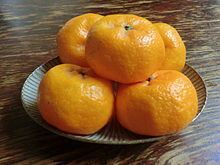 | ||
Similar Sanboken, Florentine citron, Mandora, Melogold, Bizzaria | ||
The komikan (小みかん, 小蜜柑) is a type of mandarin grown in Japan. "Ko" means "little", and "mikan" a type of citrus cultivar; komikans are unusually small. It is almost the same as the Kishumikan.
Contents
It is sometimes called a Sakurajima komikan orange (桜島小みかん, Sakurajima komikan) grown on Sakurajima, an active composite volcano in Kagoshima prefecture, Japan. The same cultivar is also grown in Fukuyama in Kirishima along Kagoshima Bay, and this is simply called komikan (小みかん, 小蜜柑).
Summary
It is a Kagoshima local product and it is the world's smallest satsuma as certified by Guinness World Records. Because the soil is rich in volcanic ash, Sakurajima is not suitable for rice cultivation, so the 'komikan' is an important commercial crop. Some of the huge trees have been standing for over 200 years and sometimes a few hundred kilograms of mikan are produced from a single tree. The fruits ripen at the beginning of December and it turns into a flattened spherical shape that weighs anything from 20 to 50 grams. Its pith is hard but sweet-tasting.
History
There are three theories about how 'Sakurajima Komikan' were first cultivated. The first is that Shimazu Yoshihiro, the second son of Shimazu Takahisa, who was the Daimyo of the Satsuma Province, took back the oranges to Satsuma from the Korean Peninsula after the two Japanese invasions of Korea (1592 and 1598). Otherwise, from Kii Province after the Battle of Sekigahara (on October 21, 1600). The third theory is that he brought back 'Takada mikan' oranges from Yatsushiro in Higo Province (present day Kumamoto). This opinion is the most popular. It has become a specialty of Satsuma because Naotomo Yamaguchi, Tokugawa Ieyasu's retainer, admired its great taste. In 1603, it was presented to Tokugawa Ieyasu by Shimazu Tadatsune, tozama daimyo of Satsuma. In ancient times, it was referred to as 'Mukoujima Mikan' or 'Aka Mikan' but it started to be called 'Sakurajima Mikan' in around 1658.
